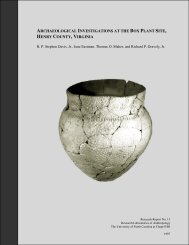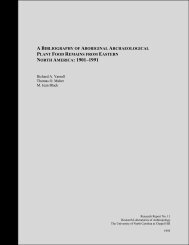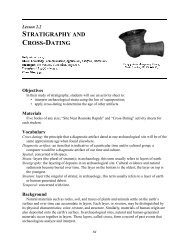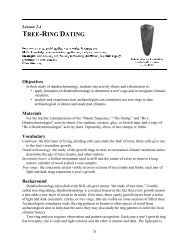inexpensive type <strong>of</strong> ware <strong>of</strong>ten used in hotels and restaurants. Hand-painted, shell-edged,transfer-printed, and undecorated Whitewares were recovered from the site (Table 3).White Granite is a plain, undecorated, fully vitrified ware (or refined stoneware)produced beginning in the 1840s and continuing until the 1890s (Figure 40a–b). In the earlydecades heavy, molded geometric shapes with 8, 10 or 12 sides were common, while laterforms are plain, round shapes. In the 1880s this type was not always completely vitrified,resulting in our use <strong>of</strong> a Whiteware/White Granite category (Miller 1980:5–6). Some waresproduced after 1880 were not vitrified at all, and were similar to the earlier Whitewares,except that the earlier Whitewares were usually decorated and the later ones usually not (seeabove paragraph). Figure 42 shows an example <strong>of</strong> a plate found at the site in this later (post-White Granite) Whiteware category. It exhibits the later plain rounded style.The different decorative styles also had specific temporal time spans. One <strong>of</strong> theearliest styles is the shell-edged decoration. This tableware was the least expensiveearthenware with color decoration (Hunter and Miller 1994:443). It was extremely popularand “accounted for more than forty per cent <strong>of</strong> tablewares sold between 1783 and 1858”(Hunter and Miller 1994:441). The style was found mainly on plate forms, and consisted <strong>of</strong> acolored rim (usually blue or green) with a plain, undecorated center.This style spanned the era from 1780 to 1860, but more exact dating is possible by“tracing the evolution <strong>of</strong> the rim shapes” (Hunter and Miller 1994:437). The earliest formwas “an asymmetrical, undulating scallop with impressed curved lines” (Figure 43e, i), whichdates from 1775 to 1810. These edges could be colored blue, green, brown, purple, red, orblack (blue and green colors were found on the site). This was followed by an evensymmetrical scalloped edge with straight or curved impressed lines between about 1810 and1835 (Figure 43f, j). These were generally colored blue or green, and were almostexclusively Pearlware. By the 1830s the style was being used with Whitewares and thescalloped rim was eliminated in favor <strong>of</strong> an even rim with impressed lines, and was almostalways colored blue. This style was popular until around 1860 (Figure 43a–b). After 1860the shell-edge style generally fell out <strong>of</strong> favor, but some wares were produced until the 1890swith an even edge and painted lines instead <strong>of</strong> impressed ones (Hunter and Miller 1994:437).The shell-edged wares recovered from the Pettigrew site were all Pearlware orWhiteware. They made up at least about 3.5% <strong>of</strong> the entire ceramic assemblage (Table 3),but the percentage is probably much higher considering the small size <strong>of</strong> the sherdsrecovered, and the fact that only the rim sherds can be identified as this style. SincePearlware was almost never undecorated, it is likely that virtually all <strong>of</strong> the undecoratedPearlware sherds recovered from the site are part <strong>of</strong> the shell-edged wares. Only two <strong>of</strong> the241 undecorated Pearlware sherds belonging to the Dining group were rim sherds; the restwere body or base sherds <strong>of</strong> flatware (plates and platter) forms. It is also likely that asubstantial portion <strong>of</strong> the undecorated whiteware sherds belonged to the shell-edged vessels,but some <strong>of</strong> the undecorated Whiteware belongs to the post-1880 era. Among the shelledgedrims recovered, the proportion <strong>of</strong> Pearlware to Whiteware was 77% to 23%. If we addthe undecorated Pearlware (239 sherds) to the shell-edged rims and add a correspondingamount <strong>of</strong> the undecorated whiteware also (55 sherds), the shell-edge wares conceivablycould make up 16% <strong>of</strong> the total ceramic assemblage sherd count, the next biggest categoryafter the undecorated refined wares (which would be correspondingly reduced from 62% to40
50% <strong>of</strong> the assemblage). If, and when, a minimum vessel analysis is made <strong>of</strong> the assemblage,this question will be more exactly understood.Of the identified shell-edged rim sherds, 67 sherds could be reliably placed into theabove four stylistic/temporal categories. Of these, 72% date to before 1835 (predating the“Poor House”), 25% date between 1830 and 1860 (the “Poor House” era) , and 3% datebetween 1860 and 1890 (spanning the “Poor House” and Roberson Hotel/Central Hotel eras).The stratigraphic distribution <strong>of</strong> shell-edged sherds is almost even between Level 2,and Levels 3 and 4 (Table 11). The two sherds dating to the hotel era (1860–1890) werefound in Level 2 and Level 4 in the northern half <strong>of</strong> the site. The distribution shows thatshell-edged wares were used in all contexts before about 1860.Shell-edged wares were replaced in popularity in the first half <strong>of</strong> the nineteenthcentury by transfer-printed wares. Transfer-printed wares make up 8.2% <strong>of</strong> the entireassemblage <strong>of</strong> ceramic sherds (Table 3). It appears that out <strong>of</strong> 204 sherds, as many as 109different patterns may be represented, although the small size <strong>of</strong> the sherds and the smallnumber <strong>of</strong> cross-mended sherds make it difficult to say precisely. This number <strong>of</strong> patterns isnot too surprising since people in the nineteenth century in general, and especially in the earlypart <strong>of</strong> the century, were not concerned with having matching sets <strong>of</strong> dishes (Majewski andO’Brien 1987:179).The transfer-print patterns were analyzed to divide them into the common stylisticcategories posed by Samford (1997). This proved possible for 71 <strong>of</strong> the patterns. Thenumber <strong>of</strong> patterns identified <strong>of</strong> each stylistic and ware type along with the years <strong>of</strong> peakproduction are shown in Table 12 (see Figures 41 and 44–46 for examples <strong>of</strong> these styles).All but three <strong>of</strong> the styles were popularly current during the probable occupancy <strong>of</strong> the“Poor House.” The manufacture <strong>of</strong> the Chinoiserie, and the Continuous RepeatingGeometric and Floral marley patterns likely pre-date the building <strong>of</strong> the “Poor House.” Themajority <strong>of</strong> patterns assigned to these categories from the site are also Pearlware (1780–1830)which also tends to predate the “Poor House.” Together, these patterns make up 45% <strong>of</strong> thetotal patterns identified. Overall, the transfer-print patterns were almost evenly dividedbetween Pearlware and Whiteware types (36 and 33, respectively) (Table 12). Vessel formsrepresented include flatware (plates, platters, etc.), hollowware (bowls, pitchers, etc.), cupsand saucers, and a child’s plate with printed motto (Figure 43k).The distribution on the site <strong>of</strong> transfer-print patterns (not sherd counts) from intactcontexts show them roughly evenly divided between Levels 2 and 4 (Table 11). From thedating <strong>of</strong> the patterns themselves, and their distribution on the site, it is clear that about half<strong>of</strong> the transfer-print wares were discarded before the construction <strong>of</strong> the “Poor House.”Transfer prints from the early nineteenth century were one <strong>of</strong> the most expensive types <strong>of</strong>decorative wares available (generally, only porcelain was more expensive), although by midcenturythey had dropped in price considerably and were affordable by most people (Miller1980:14). The many cups and saucers forms recovered indicate tea wares (indicating teadrinking), which were also more expensive than other tableware.A small amount <strong>of</strong> porcelain was recovered from the site, a little over 4% <strong>of</strong> the totalceramic sherd count (Table 3). About a quarter <strong>of</strong> the porcelain was Chinese export wares(Figure 43g), about half <strong>of</strong> which were found in Level 4. Some European hard pasteporcelain was also identified among the tablewares. Porcelain was being manufactured inEurope by 1800 (Majewski and O’Brien 1987:126). The porcelains are hard to categorize41
- Page 1 and 2: ARCHAEOLOGICAL INVESTIGATIONS AT TH
- Page 3 and 4: ABSTRACTArchaeological investigatio
- Page 5 and 6: Moffitt, Brooks Rainey, Patricia Sa
- Page 7 and 8: ChapterPage6. Conclusions and Recom
- Page 9 and 10: TablePage16. Distribution of cerami
- Page 11 and 12: FigurePage18. Excavating Sq. 140R95
- Page 13 and 14: Chapter 1INTRODUCTIONThis report de
- Page 15 and 16: Chapter 2HISTORICAL BACKGROUNDThe t
- Page 17 and 18: Book 17:59-60). Gavin Hogg paid off
- Page 19 and 20: and the sale of the western half of
- Page 21 and 22: After the Civil War, the town fell
- Page 23 and 24: train young men and women to teach
- Page 25 and 26: the university was the Delta Kappa
- Page 27 and 28: ENDNOTES1 A typescript of this deed
- Page 29 and 30: Chapter 3FIELD METHODSFieldwork was
- Page 31 and 32: Chapter 4RESULTS OF ARCHAEOLOGICAL
- Page 33 and 34: foundations were 2 ft wide and the
- Page 35 and 36: Level 2aThis soil level occurred on
- Page 37 and 38: Feature 2Feature 2 was a linear dis
- Page 39 and 40: Feature 12Feature 12 was a small, s
- Page 41 and 42: ARCHITECTURAL GROUPA large number o
- Page 43 and 44: southern and northern parts of the
- Page 45 and 46: Kitchen GroupCeramics. As shown in
- Page 47 and 48: is probably no earlier than the sec
- Page 49: consumption of wine in ante-bellum
- Page 55 and 56: sat down. Diners then helped themse
- Page 57 and 58: ecords show his property increased
- Page 59 and 60: The ceramic marbles could easily be
- Page 61 and 62: southern to northern halves of the
- Page 63 and 64: anthropomorphic pipes (Sudbury 1979
- Page 65 and 66: TOILETRIES GROUPThe Toiletries grou
- Page 67 and 68: shampoo bottles, and a cosmetic jar
- Page 69 and 70: Items likely associated with the fr
- Page 71 and 72: Chapter 6CONCLUSIONS AND RECOMMENDA
- Page 73 and 74: REFERENCESAnonymousc.1797 Plan of t
- Page 75 and 76: Majewski, Teresita, and Michael J.
- Page 77 and 78: Wilson, Louis R.1957 The University
- Page 79 and 80: Table 1 continued.Activity Group Qu
- Page 81 and 82: Table 3 continued.Category 0-2 cm 2
- Page 83 and 84: Table 7. Distribution of kitchen ce
- Page 85 and 86: Table 10. Distribution of ceramic t
- Page 87 and 88: Table 13. Distribution of glass and
- Page 89 and 90: Table 17. Distribution of pharmaceu
- Page 91 and 92: PRESBYTERIANCHURCHHENDERSON STREETN
- Page 93 and 94: Figure 4. 1797 map of Chapel Hill a
- Page 95 and 96: Figure 6. 1857 Chapel Hill Business
- Page 97 and 98: Figure 8. View of Franklin Street l
- Page 99 and 100: Figure 10. Portion of a 1911 map co
- Page 101 and 102:
Figure 12. Delta Kappa Epsilon hous
- Page 103 and 104:
Figure 14. Kemp P. Battle with Phi
- Page 105 and 106:
Figure 16. Portion of a 1932 map co
- Page 107 and 108:
Figure 18. Excavating Sq. 140R95 pr
- Page 109 and 110:
Figure 20. Removing topsoil from th
- Page 111 and 112:
Figure 22. Exposing the south wall
- Page 113 and 114:
Pettigrew Site(RLA-Or412)Architectu
- Page 115 and 116:
Stone FoundationsStone FoundationsD
- Page 117 and 118:
Figure 28. View of Structure 2 full
- Page 119 and 120:
160 150 140 130 120 110 100100 ft99
- Page 121 and 122:
Figure 32. Prehistoric lithic artif
- Page 123 and 124:
Figure 34. Miscellaneous ceramic an
- Page 125 and 126:
Figure 36. Glassware: oil lamp chim
- Page 127 and 128:
Figure 38. Stoneware: Virginia-made
- Page 129 and 130:
Figure 40. Refined, undecorated war
- Page 131 and 132:
Figure 42. Whiteware plate, 9.5”
- Page 133 and 134:
Figure 44. Transfer printed wares:
- Page 135 and 136:
Figure 46. Transfer printed wares:
- Page 137 and 138:
Figure 48. Toothbrushes and possibl
- Page 139 and 140:
Figure 50. Early to mid-nineteenth-
- Page 141 and 142:
Figure 52. Refined, undecorated whi
- Page 143 and 144:
Figure 54. Glass cosmetic and shamp
- Page 145 and 146:
Appendix 1. Chain of title for Lot
- Page 147 and 148:
30030024060300Lot 11George Johnston







